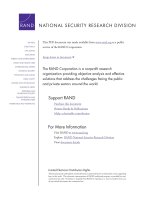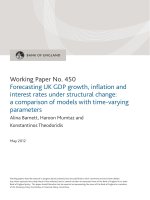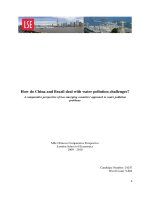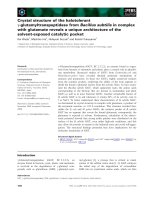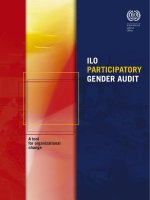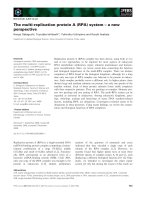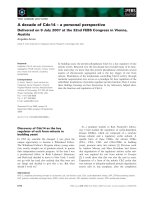COPING WITH ORGANIZATIONAL CHANGE: A MULTIDIMENSIONAL PERSPECTIVE
Bạn đang xem bản rút gọn của tài liệu. Xem và tải ngay bản đầy đủ của tài liệu tại đây (556.77 KB, 198 trang )
COPING WITH ORGANIZATIONAL CHANGE:
A MULTIDIMENSIONAL PERSPECTIVE
Stephen L. Bussell
Submitted to the faculty of the University Graduate School
in partial fulfillment of the requirements
for the degree
Master of Arts
in the Department of Communication Studies,
Indiana University
November, 2010
ii
Accepted by the Faculty of Indiana University, in partial
fulfillment of the requirements for the degree of Master of Arts.
___________________________________
Elizabeth M. Goering, PhD., Chair
___________________________________
Master’s Thesis John Parrish-Sprowl, PhD.
Committee
___________________________________
Ronald M. Sandwina, PhD.
iii
ACKNOWLEDGEMENTS
About five years ago, I was forced to leave graduate school due to circumstances
well beyond my control. Those were not happy days for me, but serious interruptions are
seldom delightful events. During that time, my friend and colleague Crystal Henderson
provided me with lively encouragement and stabilizing input at a time when hope
mattered most.
On my return, I faced the daunting task of reorienting myself to the
communications program and re-establishing myself as a current researcher and scholar. I
very much appreciate the efforts of Dr. Elizabeth Goering, my committee chair, and Dr.
Jason Eberl, associate professor of philosophy, for helping me navigate through that
bumpy terrain. Without their help, I would not have been able to revalidate my previous
academic achievements and fulfill all the requirements needed for graduation.
Concerning my present work, it is with a special emphasis that I express my
gratitude, once again, to Dr. Elizabeth Goering for offering invaluable advice and
direction during the initial stages of the project. Following her suggestions, I fine tuned
my ideas by expressing them in picture form and probed more deeply into my subject
matter by re-examining my descriptive vocabulary.
With respect to my overall education, I would like to acknowledge three
important individuals in alphabetical order:
I thank Dr. John Parrish-Sprowl for dramatizing the importance of asking
questions and for encouraging me to open my mind to theories of communication that
tugged away at my carefully nurtured and overly guarded world views.
iv
I thank Dr. Ronald Sandwina for familiarizing me with the broad range of
interpretive research methods, including the technique of detecting patterns in research
data and translating them into meaningful categories.
I thank Dr. Kristina Sheeler for emphasizing the all-important line of demarcation
that separates analysis from evaluation and for providing me with numerous opportunities
to put that distinction into practice.
v
ABSTRACT
Stephen L. Bussell
COPING WITH ORGANIZATIONAL CHANGE:
A MULTIDIMENSIONAL PERSPECTIVE
This paper introduces a unified model for organizational change that is designed
to help change analysts think through the decision-making process. Most organizational
leaders do not manage change effectively because they fail to acquire the minimum
amount of information necessary to make a sound decision. In large part, this deficiency
is a result of considering only a small part of the organization’s total change reality,
which can be expressed in terms of the following four categories: 1) Environment creates
change, 2) Organization responds to environmental change, 3) Organization initiates new
changes, and 4) Organization changes environment. Through the principle of diagnostic
communication, leaders can adjust to the incoming changes [categories 1 and 2]. Through
the principle of rhetorical communication, they can create effective outgoing changes
[categories 3 and 4]. Through the principle of dialogical communication, they can
achieve a strategic balance between too much conformity, which results from diagnostic
communication in isolation, and too much non-conformity, which results from
communication in isolation. By understanding and communicating about change from
this multi-dimensional perspective, organizational leaders, both designated and non-
designated, can learn to appreciate the extent to which they influence and are influenced
by the larger cultural environment of which they are a part.
Elizabeth M. Goering, Ph.D., Chair
vi
TABLE OF CONTENTS
SECTION I:
A NEW MODEL FOR CHANGE 1
Introduction 1
Review of Change Literature 4
Mental Models and the Proglem of Fragmented Thinking 7
The Four Change Paradigms 11
The External Change Paradigm 11
The Change Adjustment Paradigm 12
The Internal Change Paradigm 13
The Change Creation Paradigm 14
Finding Common Terms. 15
The Change Model 16
The Communications Triad 19
Diagnostic Communication 20
Rhetorical Communication 21
Dialogical Communication 22
Diagnostic Communication and the Problem of Priorities 23
Rhetorical Communication and the Problem of Language 26
Dialogical Communication and the Problem of Balance 30
Strategic Balance Theory 31
Dialogical Communication and Co-creation 33
vii
SECTION II:
USING THE CHANGE MODEL FOR ARGUMENT AND ANALYSIS 36
Quadrant 1: Environment Creates Change 37
Methods for Identifying Trends 38
Distinguishing Between Problems and Opportunities 40
The Interpretive Mind Set 42
Understanding the Culture. 43
Understanding the Economics. 47
Understanding the Technology 50
Technology as Connector 50
Technology as Equalizer 51
Technology and Values 53
Technology in the Broader Context 54
Quadrant 2: Organization Responds to Change 56
Management by Objectives 57
Asking the Right Questions 59
Managing Causes Rather Than Effects 61
Planned Change vs. Emergent Change 65
Top Down vs. Bottom Up Direction 69
System Theory and the Problem of Linear Vectors 70
Organizational Change, Sensemaking, and Reinventing the Wheel 72
Social Construction Theory and the Problem of Perception 74
viii
Quadrant 3: Organization Initiates New Changes 77
Approaches to Creativity 79
The Significance of Symbolic Interaction 81
The Importance of Psychological Traits and the Organization’s Culture 84
Grid Theory and Organizational Conflict 86
Grid Theory, Self Delusion, and the Problem With Situational Leadership 89
Beyond Conflict 92
Straight Talk About Communication and Synergy 93
Risk, Failure, and the Lunatic Fringe. 95
Working Through the Paradox 100
The Problem With Forced Creativity 102
Quadrant 4: Organization Changes Environment 104
Rhetorical Communication, the Message, and its Transmission 105
Good Brands, Uniqueness, and the Emotional Connection 106
Marketing Physics 108
Good Brands and Their Stories 111
Good Brands and Their Strategic Design 112
Persuasion and the Art of the Narrative 114
American Culture, Politics, Education, and the Problem of Style
Over Sustance 115
Using the Right Words 116
Avoiding Negatively Charged Phrases 118
The Ethics of Rhetorical Communication 119
ix
The Need For Ethical Reform 121
The Importance of Ethical Communication 123
Political Campaigns, Persuasion, and the Problem of Clarity 124
Public Communication, Social Movements, and the problem of the
Common Good 126
The Organization’s Obligation to Communicate Honestly 127
SECTION III:
TESTING THE MODEL 130
Rationale 130
Description of Language Codes 132
Background 133
McCain Chooses Palin 134
Palin Creates Excitement and Makes a Marginal Difference 137
The Press Chooses Obama 140
McCain Misses a Big Opportunity 142
Debates and the Confirmation of Brand Image Psychology 145
Debate Momentum and Image Management 146
Brand Images in Flux 149
Hearkening Back to the Primaries 153
Obama Campaign Aligns Political Messages With Public Perceptions 157
Why it Happened and What it Means 161
The Importance of Strategic Thinking and a Sound Communication
Strategy 162
x
Post Election Realities and the Future of Political Change
Management 165
CONCLUSION 167
Appendix A - Definition of Diagnostic Communication 170
Appendix B – Definition of Rhetorical Communication 171
Appendix C – Definition of Dialogical Communication 172
REFERENCES 174
CIRRICULUM VITAE
1
SECTION I: A NEW MODEL FOR CHANGE
Introduction
While most organizational leaders seem to know that change is both unavoidable
and unpredictable, many fail to confront it in a meaningful and proactive way. In some
ways, their hesitancy is understandable because change can mean discomfort, disruption,
disorientation, and even stress for anyone who is being asked to manage it or cope with it.
It is little wonder, then, that decision-makers often seek out advice from change
specialists, academics, or business leaders capable of providing new insights on change
strategy.
As change analysts inform us, globalization, technological improvements, and the
new knowledge economy, while providing numerous economic benefits on a large scale,
have, at the same time, flooded the communicative environment with a potentially
unmanageable quantity of information, making it increasingly difficult for organizations
to communicate and make sound decisions about change. Now, suddenly, in the midst of
this complex cultural shift, the business world has been burdened with an anxiety-
producing economic crisis that threatens to shake the foundations of the commercial
enterprise itself. Predictably, many organizations are in a state of flux, uncertain not only
about their own future but also about the market-driven system that established the rules
for doing business in the first place.
As a result, priorities for growth and development have, in many respects, given
way to urgent concerns for survival, causing management to focus less on trying to win
and more on trying not to lose. If the late Abraham Maslow could return to describe this
new phenomenon, he might argue that many of our institutions have stopped striving for
2
“ego satisfaction” and “self-actualization,” focusing instead on “basic needs” and
“security.” Decision makers often ask questions such as these: “How do we make it until
things get better?” or “Are we going to make it at all?” Among private organizations, or
course, it has always been the case that most new businesses fail early, so there is nothing
new in the idea that an organization can be on the losing end in the battle for competitive
advantage. What has changed, though, are attitudes and perceptions about what
constitutes a fair playing field and who, if anyone, deserves to be designated as “too big
to fail.”
This paper will introduce and test a new model for organizational change in the
hope that, if organizational leaders understand and communicate about change in a
comprehensive way, that is, from a multidimensional perspective, they can learn to
successfully cope with a wide variety of problems, make sense of their change strategy,
and improve the communication/decision-making process. In that sense, the report, while
recognizing contemporary problems, is not time sensitive; the change model and its
corresponding approach to communication strategy will apply to and illuminate most
contemporary problems associated with organizational change.
While a great deal of academic literature exists on the subject of group decision
making, I have focused mainly, though not exclusively, on “public scholar” literature. It
is unfortunate that I find it necessary to exclude such a rich body of well-thought out
research, but this strategy serves both the reader and, in this case, the researcher.
Anticipating the reader’s vantage point, I submit that organizational leaders are
more likely to find a comprehensive analysis of their main concerns in a well-publicized
book than in a scholarly article. Unlike communication researchers, who tend to focus on
3
one narrowly-focused empirical study, authors who write books about organizational
change typically cast their nets much wider, drawing from a wide variety of intellectual
resources. As such, they often provide useable, practical and generalizable advice based
on numerous studies. Also, writers who achieve high visibility are often invited to make
their case in other public venues, enhancing their influence and making it easier for them
to frame organizational issues in a language that is likely to resonate with decision
makers. Thus, by using this material and the familiar language associated with it, I hope
to reach common ground with those entrusted with the responsibility of coping with
change in an organizational environment.
Speaking from the researcher’s vantage point, I have found that books typically
contain complete thought systems or arguments, the substance of which can serve as
emerging data from which meaningful categories can often be detected. I sought, as
Meyer (2009) puts it, to “function as a detective who is trying to solve a mystery by
collecting clues and developing a case.” Among other things, I wanted to know what
organizational change looks like from a “big picture” perspective. From that new vantage
point, I reasoned that I would gain valuable insights about how organizations can better
cope with organizational change and make sound decisions in that context. Thus, it was
necessary to assemble pieces of the puzzle one step at a time. In this observer’s opinion,
books often reflect this broader analysis better than scholarly articles by virtue of the
sheer volume of information contained in them. As the input of relevant information
increases, the patterns that emerge become more clearly perceived and are more likely to
reflect the real world.
4
On a related point, my aim is not to challenge the validity of any given
communication theory, but rather to utilize various communicative approaches in order to
illuminate the subject matter. I am framing public scholarship related to organizational
change from a communication perspective for the sole purpose of developing a new way
of understanding organizational change. By no means do I seek to address all the
substantive issues related to communication theory. To be sure, there will be times when
I find one communication theory more useful than another, but that effort should not be
interpreted as a judgment about the overall utility of any one perspective.
Section one of the report will contain a review of the change literature, provide a
brief description of the ironies and paradoxes inherent in the challenge of coping with
organizational change, highlight the self-limiting problem of fragmented thinking, and
present for the first time, a solution to that problem a four quadrant change model that
describes the total change reality that all organizations must face. To further support this
model, I will also introduce a tripartite communication strategy for applying these four
change quadrants. Section two of the report will extend on the principles found in section
one, providing an overview of how each change quadrant may be used to enhance the
organization’s communication and decision making process. Finally, in section three I
will set up a case study to test the model and show how it can be used to analyze and
cope with any change situation.
Review of Change Literature
Although the literature on change is both informative and abundant, it can also be
confusing and even a little maddening. Disagreement exists not only about what
constitutes good change strategy, but also about the very nature of the organization and
5
even about the nature of change itself. As change analysts, we appear to have listened to
too many answers and asked too few questions, especially the kinds of questions that
highlight the inconsistencies found in the change literature. Among the many possible
standards for measuring organizational excellence, for example, which one of the
following matters most? Is it long-term profitability (Randolph, 1979), stockholder value
(Jensen, 2000), customer service (Drucker, 2005) organizational development (Schein,
1985), or the management of talent (Senge, 1998)? One will encounter no difficulty in
finding change analysts who will argue strenuously for each position.
Does effective change begin at the top (Ghoshal, 1998), or does it emerge from
the bottom (Weick, 1995)? Should change analysts focus primarily on changing the
organization’s structure (Dunphy, 2000) or should they pay more attention to
transforming its culture (Bennis, 2000)? To choose the consultant is to have chosen the
answer and one’s organizational strategy in advance. Yet, the problem persists. Should
organizations be soliciting advice from consultants without asking all the preliminary
questions about what kind of advice they may be getting? Extending the point, some
experienced executives recommend gradualism, or, as it is often characterized, “constant
and never ending improvement,” (Kanter, 1997; Regan, 2000) while others warn us
against the dangers of “polishing yesterday’s apple,” as they continually dramatize the
folly of perfecting the obsolete (Peters, 2003). So, which is it? Do we polish the apple or
not? In keeping with that point, how do we reconcile one analyst’s proposal to establish a
change culture (Kotter, 1998) with another specialist’s assertion that “it is easier to kill an
organization than to change it” (Kelly, as cited in Peters, 2003, p. 31)? From these
6
quarters, at least, it appears that too many analysts are providing solutions without
seriously weighing their implications.
Even on the subject of change in the abstract, debate rages. Does change have a
core, meaning are there are some unchanging realities around which change occurs
(Naisbett, 2005) or does it, as social constructionists tell us, admit of no final anchor
point (Mazaar, 1999)? This is no small problem. If change has a core, organizations
ought to maintain a semblance of stability and build their structure and culture around
that core, namely its unifying purpose or mission. If change does not have a core, then, as
Gilmore and Pine (2009) have suggested, the organization’s mission is perpetually
subject to change and, one gathers, should be subordinated to and aligned with market
demands and other environmental influences, even if that means abandoning its original
reason for being. Even at that, is “culture” something that leaders should build with an
end in mind, or is it something that should be allowed to evolve in its own way? Pressing
the issue even further, especially on the matter of inter-organizational communication,
should organizations attempt to exert a linear influence ON the consumer by inculcating
persuasive symbols and brands in the public consciousness, (Stiff, 2006) or should they
establish a reflexive dialogue WITH their consumers in the form of a trust relationship
(Peppers and Rogers, 2008)? Is public communication and persuasion about giving
people what they want, or is it about changing them to want what the organization wants
them to want? Should organizational leaders conform to a universal code of ethics, or
should they think of themselves as being in “a war of all against all,” or, as former CEO
Paul Allaire puts it, (as cited in Peters, 2003, p. 23) “a brawl with no rules?” These are
only a few of the numerous paradoxes and challenges that cannot be adequately
7
accounted for in a review of the current literature. How, then, can we reflect reality as
clearly and accurately as possible without oversimplifying the matter? So far, the typical
organization’s approach to confronting these and other questions is this: Don’t ask; don’t
tell. Just choose your favorite theorist and have faith.
Mental Models and the Problem of Fragmented Thinking
Putting aside for a moment the question about how change analysts should think
about reality, it is well to consider how, in fact, they do think about reality. This brings us
to the current state of affairs and the organizational leader’s typical, one could even say,
universal approach to coping with change. Research shows that, from an individual
perspective, every action that managers take is based on some theory even if it is not
explicitly verbalized (Christensen and Raynor, 2003), a theory some would describe as
“intuitive” (Beer and Nohria, 2000). Without embracing some world view about what
change is, how it works, and what the organization can do about it, most decision makers
could not plan a consistent strategy for transforming an organization or make a
persuasive case for implementing it. While they may not be able to define their world
view, indeed, while they are not likely even aware of it, they do tend to act in a way that
is consistent with some unified set of perspectives (Carr, 1996). Otherwise, they could
not make sense of their change environment or decide what it is likely to mean for the
organization.
On the other hand, the current research does not describe, define, or identify these
intuitions or implied world views, nor does it hint at how many there might be. As this
paper will soon make clear, there are four identifiable, yet unrecognized, change models
that influence organizational strategy and that most change analysts unconsciously
8
choose from one of those four to illuminate their change strategy. Since each of these
models reflects only a small part of the total change reality, none can incorporate the full
range of perspectives needed to foster effective communication and sound decision
making.
Isolated from the big picture, each mental model, though informative in its limited
context, prompts the decision maker to focus only on those problems or opportunities that
are made evident in that context, while discounting or even ignoring those that are not.
Without realizing it, organizational leaders unconsciously engage in what Parrish-Sprowl
(2003) has characterized as “the privileging of a perspective” (p. 292). Mistakenly
believing that they have acquired the minimum amount of information needed to make a
sound decision, or, having no model that will stimulate the right kinds of questions, they
often develop premature and unrealistic change strategies, or in some cases, given the
paradoxes and contradictions found in the change literature, despair even of setting the
sound objectives around which a realistic strategy can be formed. All too often, this
fragmentary analysis of the change dynamic leads to unnecessarily radical approaches for
coping with it. Until the current economic crisis, organizational leaders had become
especially vulnerable to one of two extremes: Some erred on the side of undue
pessimism, slavishly reacting to popular trends as if they had little or no power to create
change; others erred on the side of undue optimism, pushing one bold initiative after
another as if their powers were limitless. Predictably, current challenges have prompted a
movement back toward pessimism, but the proclivity to rely on a constricted and
fragmentary mental model persists.
9
Adding yet another element of complexity, decision makers inside the
organization often seek counsel from outside change specialists, all of whom embrace
their own favorite paradigm and the strategy or strategies that derive from it. Thus, there
is no guarantee that consistency or continuity will follow from one consultant to the next,
adding yet one more in a series of destabilizing events. Research shows that, among all
new programs initiated by change experts, only one third create a positive benefit (Hall,
Rosenthal, and Wade, 1994). According to Robbins and Finley (1996), one Midwestern
institution subjected its employees to nine major strategic changes over a seven-year
period, which included experiments in Quality Circles, TQM (Total Quality
Management), Reengineering, Mission and Vision, Delayering, Learning Organization,
Teams, Customer Satisfaction, and Empowerment. Ironically, all this tinkering with the
organization’s structure stems from the constricted and simplistic notion that
organizations can do little more than react to the world around them, a world view that
can and will be included as one of the four change paradigms.
The situation is somewhat more varied with scholars, change specialists, and all
those who theorize about organizational change. Like organizational leaders,
theoreticians implicitly work and think through unidentified and undefined change
paradigms to arrive at meaningful change strategies. Unlike organizational leaders,
theorists may well consider subject matter on a scale broad enough to suggest two or
more of the four mental models, but they do not recognize them as models or as parts of a
larger whole, and cannot, therefore, integrate them into a comprehensive framework for
understanding the total change reality. “An integrated theory or framework for
understanding change does not exist” (Beer and Nohria, 2000, p. 1). Although the
10
literature on change management fails to take account of these aforementioned change
categories, a few authors have developed operational terms that hint at them, providing
the raw materials for further analysis and interpretation. Several analysts have written
about what might be described as the inside/outside dimension. Bossidy and Charan
(2004), for example, imply two categories, contrasting [a] “external realities, which
include overall business environment, history of the industry, and customer base,” with
[b] “internal activities, which include strategy, operations, and people” (p. 6). Making
almost the same point, Bishop (2001), distinguishes the act of “assessing the reality of the
world” with the act of “assessing the change capacity inside the organization” (p. 110).
Also, it should be noted that some thinkers have approached the special problem of
organizational “uncertainty” first in terms of unpredictability from changes in the
external environment, (Chandler, 1962), and later as a phenomenon grounded in the
subjective, and largely internal processes of perception, (McGrath, 1970).
Other analysts have hinted at a second dimension that might be characterized as
the change-adjustment/change creation dimension. Drucker (1993), for example,
differentiates between “anticipating a future that has already happened” and “imposing
on the yet unborn future a new idea that tries to give direction and shape to what is to
come” (p. 173). Describing a similar relationship, Randolph (1979) marks the difference
between managing the organization’s momentum (trend impact) and managing its
potential (resource capability). In a slightly different context, Sutcliffe (2001) points out
that organizations can be reactive or pro-active as they manage the flow of information.
Dramatizing the point in jurisprudential language, Pepper and Rogers, (2008) distinguish
11
institutional “laws” that cannot be avoided and must be followed (conforming to the
status quo) from “rules” that can and should be broken (changing the status quo).
What becomes evident is the fact that both dimensions (external change/internal
change) and (change adjustment/change creation) underlie the total change phenomenon
and that each of the four elements involved can be translated into a meaningful and
comprehensive change paradigm that reflects the current influences on communication
and decision making.
The Four Change Paradigms
In its own way, each change paradigm prompts the organization to orient itself to
the future in accordance with a strongly implied set of assumptions. Not surprisingly,
each one, though incomplete, tends to masquerade as the total change reality.
The External Change Paradigm.
This first category focuses on opportunities and problems found outside the
organization. Some analysts, such as Naisbett (1998) and Toffler (1981), emphasize the
first category insofar as they specialize in examining the external environment, focusing
on mega-trends, globalization, and multi-nationalism. These futurists, as they are often
labeled, study political, environmental, economic, and cultural dynamics primarily as
supra-organizational factors that are likely to impact the organization sooner or later. As
Naisbett puts it, “My one -word message for the twenty-first century is ‘Asia” (p. 212).
Implied but not stated is the notion that the external is primary and the internal is
secondary.
Friedman (2005) presents a similar world view with a different twist, enumerating
the many risks and opportunities inherent in a world which has become flat. He argues
12
that hierarchies are deteriorating, meaning that any individual or country can become a
player in the world’s economy. His message is clear: If organizations are to gain a
competitive advantage in a flat world, they must learn how to change and align
themselves with it. The key competency for this paradigm is “detection” the ability to
discern which, and in what ways, elements external to the organization’s existence are
likely to affect it.
The Change Adjustment Paradigm.
The second paradigm holds that change is something that begins in the external
environment but which also immediately establishes itself as a new reality to be reckoned
with, inducing the organization to conform to that new reality. Change is, therefore,
something to which the organization must adapt, meaning that it must develop intra-
organizational functions and strategies that harmonize with trends as they occur and as
they are detected in the external environment. Just as the external change paradigm
described above, this world view constitutes a fundamentally reactive response to change.
Insofar as the organization depends on information about trends to shape its
future, it is adjusting to change, assuming a reactive rather than a proactive approach to
change. Bennis (1994) writes, “If change has now become a permanent and accelerating
factor in American life, then adaptability to change becomes the most important
determinant of survival” (p. 43). In this context, the organizational capabilities that matter
most are structural flexibility and the internal readiness for change the capacity to
become flexible, mobile, lean and mean.
13
The Internal Change Paradigm.
Unlike the two patterns described above, the third paradigm is “proactive,”
emphasizing intra-organizational culture and its capacity to facilitate creative ideas.
Accordingly, it rejects the reactive approach to change management, focusing instead on
intra-organizational dynamics and the capacity to conceive a new change reality. Bennis
(1998) argues that the major challenge for leaders in the twenty-first century will be how
to release the brainpower of their organizations. [Notice that this same author was also
cited in the second paradigm, confirming the point that some analysts are not limited to a
singular world view]. In support of this same theme, Covey (1998) insists that the key to
managing change is to change managerial perspectives so as to help people inside the
organization find meaning and fulfillment, and to create high trust cultures by finding and
developing principle-centered leaders. The essence of this paradigm is that, from the
standpoint of growth and development, what happens on the inside of the organization
counts for more than what is going on outside its boundaries.
From this perspective, what matters most is the ability to establish and maintain a
culture in which creativity can flourish. Accordingly, the organization de-emphasizes the
importance of environmental scanning and stresses the importance of establishing an
idea-oriented environment conducive to innovation. Change analysts with this mind set
ask such questions as this: Is there a creative process and what are the steps involved? If
indeed such a process exists, will it flourish better in an environment characterized as
relaxed stimulation or one that reflects time pressures and deadlines?
14
The Change Creation Paradigm.
Like the internal change paradigm above, this final mental framework is
proactive; it bids organizations to stop waiting around for change to happen and to
become change agents. In this, sense, it builds on the released brainpower implied in the
internal change paradigm described above and extends it to the point of influencing the
external environment. Just as the internal change paradigm focuses on the conception of a
new idea, the change creation paradigm focuses on the task of converting a new idea into
a marketing reality. By developing the organization’s potential to create trends and
communicate those trends, decision makers can, in effect, take charge of the change
phenomenon and exert influence on the external environment. Appropriately, Handy
(1998) insists that “the great excitement of the future is that we can shape it” (p. 16).
Paraphrasing George Bernard Shaw, he reminds us that, “the reasonable man responds to
the world, while the unreasonable man tries to make the world respond to him. All
progress (and disasters) comes from the unreasonable person, the person who consciously
tries to change the world” (p. 24).
Unlike the two adaptive patterns, this paradigm characterizes the organization or
business as a potentially mighty force, one which can, under the right circumstances,
transform the very supra-system of which it is a part. Notice also that the change process
can be thought of as beginning not with the trends in the external environment but rather
with the initiatives launched inside the organization. In this context, it is fascinating that
Kuczmarski (2000) has found ways to measure the profit return on innovation. With this
paradigm, what matters is the organization’s capacity to innovate in a spirit of non-
conformity “to believe that something that has never been done is possible where all
15
your historical evidence says, ‘no, no, no’ but your heart says ‘yes’” (Senge, 1998,
p. 145).
Finding Common Terms.
It seems evident that these four paradigms, now uncovered and made explicit for
the first time, provide a new and important way of understanding organizational change.
The total change reality, after all, seems to include not just one or two of these previously
unidentified change paradigms, but all four. Still, this new understanding, while valuable
on its own terms, does not fully solve the problem of fragmented thinking. In order to
convert these paradigms into a comprehensive change model, one final and vitally
important modification is necessary. To understand the total change reality, the analyst
must also consider how each paradigm relates to the other, how each relates to the whole,
and most important, what they all have in common. More precisely, the model must
answer three questions: What activities with respect to change does each paradigm
represent? how do the activities of each relate to the other in common terms? and how
can each activity be expressed as part of a larger whole?
